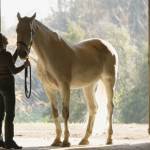The Way to a Horse’s Heart Is Through Its Stomach

Bonding is the process of developing a close relationship and is very important in strengthening human interaction with horses. Discovering the key to bonding would therefore be useful in training.
Food reward has been known to facilitate learning and solidify the attachment of humans to horses. Tactile contact, such as stroking and grooming, is thought of as positive reinforcement of desired behavior for many domestic animals, including horses. To learn more about the best trigger for bonding and learning, French and Polish researchers put together a study on the effect of either food or grooming on the speed of learning among horses and on the bonding of horses to humans.
The study was done at the Research Center in Polpielno, Poland. Researchers used 20 yearling and two-year-old Konik horses for the study. These horses were either raised domestically (12) or semi-naturally (8) on a large forest reserve until 10 months of age. Thereafter, they were raised together domestically in loose stables in large multi-age groups that allowed social grooming. The only human contact other than the experimental training was daily tethering for feeding. Horses were randomly allotted to one of two groups: food reward (rewarded for correct behavior with a piece of carrot) or grooming reward (rewarded for correct behavior by vigorously scratching the withers three times).
To test the speed of learning, each horse underwent a training program to teach it to stand immobile on vocal command for one minute; the time the horse stood still was measured each day. To test bonding between human and horse, the researchers performed a “motionless human test,” during which the trainer and horse were alone in the stable and the amount of time for the horse to approach the human and willingness to remain within 0.5 meter (about 1.75 feet) of the human was measured. Each test was limited to 5 minutes per day and the testing period lasted 6 days.
The results illustrated clear differences between type of reward in both learning performance and relationship with humans. Researchers found that nearly all the horses (9 out of 10) in the food reward group not only learned to stand still for 1 minute within the 6-day period, but they also progressed more rapidly through the training. Only 4 out of 10 horses receiving the grooming reward learned to stand for 1 minute, and at the end of the training period, the group only averaged 30 seconds. Further, the food reward group distinctly showed a preference for approaching the human quicker and staying close longer than the grooming reward group. In fact, during the testing period, the grooming reward group did not improve in either of these tests, indicating that grooming may not be perceived as sufficient reward to promote bonding to humans.
This research study clearly showed that food was much more effective at reinforcing desired behavior in horses and forming a bond to humans than grooming. Previous studies have shown that extended grooming had a positive effect on horses measured by a decrease in heart rate, so the benefit of grooming in forming a relationship with humans should not be dismissed. The value may lie in using food as a primary force for bonding or learning and grooming as secondary reinforcement.
Interpreted from the following published research article: Sankey, C., S. Henry, A. Go´ recka-Bruzda, M.A. Richard-Yris, and M. Hausberger. 2010. The way to a man’s heart is through his stomach: What about horses? PLoS ONE 5(11): e15446.doi:10.1371/journal.pone.0015446.








